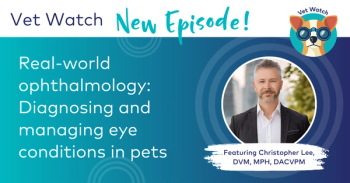
Pediatrics: What can go wrong and how to fix it (Proceedings)
Pediatrics, for the purpose of this lecture, will be considered conditions that are genetic, congenital, and early developmental and acquired. They are common in the first year of life. To have the best understanding of many of the genetic and congenital diseases, a review of embryology will be necessary, and we will further highlight embryology as we discuss many of these conditions.
Pediatrics, for the purpose of this lecture, will be considered conditions that are genetic, congenital, and early developmental and acquired. They are common in the first year of life. To have the best understanding of many of the genetic and congenital diseases, a review of embryology will be necessary, and we will further highlight embryology as we discuss many of these conditions.
Genetic conditions are those proven to have an actual genetic basis, or are highly suspicious based on familial tendencies. Congenital conditions are those that are present at birth, which may have either genetic or embryological disease implications. Early developmental diseases often have a genetic basis but may be aggravated by environmental influences. Acquired conditions, such as trauma and infections, will be discussed that are more likely to occur in the very young.
We will discuss the conditions based on the tissue involvement, including eyelid, conjunctiva, cornea, iris, lens and retina.
Routine Examination
It is recommended that a routine systematic approach be used to evaluate young patients for various ocular conditions. This makes the owners aware of problems and adds value to the examination process. I recommend that an initial periocular and anterior segment exam take place at the first puppy exam between six and eight weeks of age. This would include a magnified view of the lid margin, the third eyelid, the cornea, conjunctiva, iris and lens. Once those findings have been noted in the chart, at a followup examination, it would be reasonable to dilate the pupils as soon as the patient presents to allow dilation while waiting to be placed in the exam room. At this exam, which may be performed anywhere from ten to twelve weeks of age, direct and indirect ophthalmoscopy techniques should be used to evaluate the lens, vitreous and retina.
Eyelid
Pediatric conditions of the eyelid include distichiasis, eyelid agenesis and entropion. Conditions of the third eyelid will be discussed, including everted cartilage and prolapsed gland of the third eyelid. Other conjunctival and corneal diseases include dermoid cysts and corneal dystrophies. Prolapsed gland of the third eyelid is a common anomaly in four- to eight-month-old dogs. Various breeds are over-represented and include the Lhasa apso, American Cocker Spaniel and English bulldog. We will discuss presurgical evaluation of these patients to select the best surgical technique. Because the gland of the third eyelid is responsible for 30-40% of the tear production, it is recommended that dogs with normal/low Schirmer tear test values be considered candidates for repositioning surgery. Loss of the gland of the third eyelid may place these patients into a dry eye condition. Various surgical techniques will be reviewed and discussed.
Entropion can be an early developmental problem in the Shar-Pei as early as four to six weeks of age and other breeds more commonly in four to eight months of age. Larger breeds that mature late may not develop entropion until eight to twelve months of age. Various temporary techniques to correct the problem to allow the patient to "grow into" their eyelids will be discussed, using both suture material and surgical staples.
Conjunctiva And Cornea
Common conditions seen of the conjunctiva that may involve the cornea are dermoid cysts and symblepharon associated with neonatal infections. Various remedies will be reviewed and discussed. Corneal dystrophy, although it may be genetic, typically does not occur until two to three years of age but still may be considered for this purpose a pediatric condition.
Iris
Iridal conditions include congenital iris colobomas and persistent pupillary membranes. Persistent pupillary membranes are a remnant of the vascular tunic that nourishes the embryonic lens and are normally present up to six to eight weeks of age. Classification of persistent pupillary membranes includes iris-to-iris, iris-to-cornea, and iris-to-lens. The latter two have disease implications as they may cause opacities of the cornea or cataracts to the lens. This condition would disqualify individuals from breeding programs.
Lens
Lens conditions that are common in the neonate and early pediatric patient are microphakia and congenital cataracts. Nutritional cataracts are observed in puppies fed an artificial diet. The severity is associated with how early the artificial diet was started, its relative percentage in the total diet and the length of time that it was maintained.
Retina
Retinal conditions include various genetic anomalies, such as retinal folds, retinal dysplasia, choroidal hypoplasia and optic nerve colobomas.
Canine Eye Registry Foundation
The Canine Eye Registry Foundation is charged with certifying dogs free of genetic ocular disease. These are examinations that may be performed on puppies as early as six weeks of age for the congenital diseases and are part of an annual evaluation of breeding animals. The certification is only valid for a 12-month period. Puppies from certified parents will carry the C.E.R.F. certification number on the puppy registration forms. This assures news owners that the puppies they have acquired are from certified stock. The patients typically have their eyes dilated prior to examination except for Australian shepherds, Dalmatians and breeds known to have persistent pupil membranes
Newsletter
From exam room tips to practice management insights, get trusted veterinary news delivered straight to your inbox—subscribe to dvm360.






